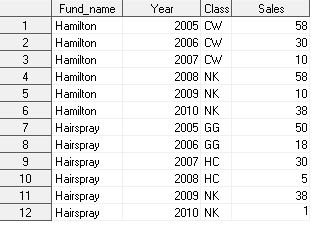- Home
- /
- Programming
- /
- SAS Procedures
- /
- Revised Q: output any row from Dataset B whose x matches x in Dataset ...
- RSS Feed
- Mark Topic as New
- Mark Topic as Read
- Float this Topic for Current User
- Bookmark
- Subscribe
- Mute
- Printer Friendly Page
- Mark as New
- Bookmark
- Subscribe
- Mute
- RSS Feed
- Permalink
- Report Inappropriate Content
Dataset A:
Dataset B:
In this case, I'm hoping to create some procedure (could be a macro,... for example, let's say macro below)
%MACRO findpeers(Fund_name)
....
such that if "Fund_name" = "Hairspray", then it will go through and output every row in Dataset B that has a matching "Class" for any of the rows -- that is, any row in Dataset B that has GG, HC, or NK as the class gets outputted as Dataset C.
So %findpeers (Hairspray) should output the following dataset:
Dataset A is maybe ~100 rows by 20 columns
Dataset B is maybe 1 million rows by 20 columns
Thank you!!
Accepted Solutions
- Mark as New
- Bookmark
- Subscribe
- Mute
- RSS Feed
- Permalink
- Report Inappropriate Content
First, get the program working for Hairspray without any macro language. You can always convert it to a macro afterwards.
Here's the idea of a SQL join. You may need to correct the syntax, however!
proc sql noprint;
create table results as select * from B
where class in (select distinct class from A where a.fund_name="Hairspray");
quit;
- Mark as New
- Bookmark
- Subscribe
- Mute
- RSS Feed
- Permalink
- Report Inappropriate Content
Why a macro? Wouldn't a SQL join be sufficient?
- Mark as New
- Bookmark
- Subscribe
- Mute
- RSS Feed
- Permalink
- Report Inappropriate Content
Please do teach 🙂 (I am such a beginner)
- Mark as New
- Bookmark
- Subscribe
- Mute
- RSS Feed
- Permalink
- Report Inappropriate Content
OK I revised the question. I realized I wasn't representing the question accurately.
In case of the new question, not sure if a sql join would work...because it's not exactly matching anymore?
- Mark as New
- Bookmark
- Subscribe
- Mute
- RSS Feed
- Permalink
- Report Inappropriate Content
First, get the program working for Hairspray without any macro language. You can always convert it to a macro afterwards.
Here's the idea of a SQL join. You may need to correct the syntax, however!
proc sql noprint;
create table results as select * from B
where class in (select distinct class from A where a.fund_name="Hairspray");
quit;
- Mark as New
- Bookmark
- Subscribe
- Mute
- RSS Feed
- Permalink
- Report Inappropriate Content
Thanks!
The final code ended up being:
%MACRO findpeers_inclusive(fundname); proc sql; create table atissue.&fundname._peers_inclusive as select * from atissue.potentialpeers where class in (select distinct class from atissue.atissue where fund_name = "&fundname"); quit; %MEND findpeers_inclusive;
%findpeers_inclusive (Hairspray);
%findpeers_inclusive (Hamilton);
April 27 – 30 | Gaylord Texan | Grapevine, Texas
Registration is open
Walk in ready to learn. Walk out ready to deliver. This is the data and AI conference you can't afford to miss.
Register now and lock in 2025 pricing—just $495!
Learn the difference between classical and Bayesian statistical approaches and see a few PROC examples to perform Bayesian analysis in this video.
Find more tutorials on the SAS Users YouTube channel.
SAS Training: Just a Click Away
Ready to level-up your skills? Choose your own adventure.




